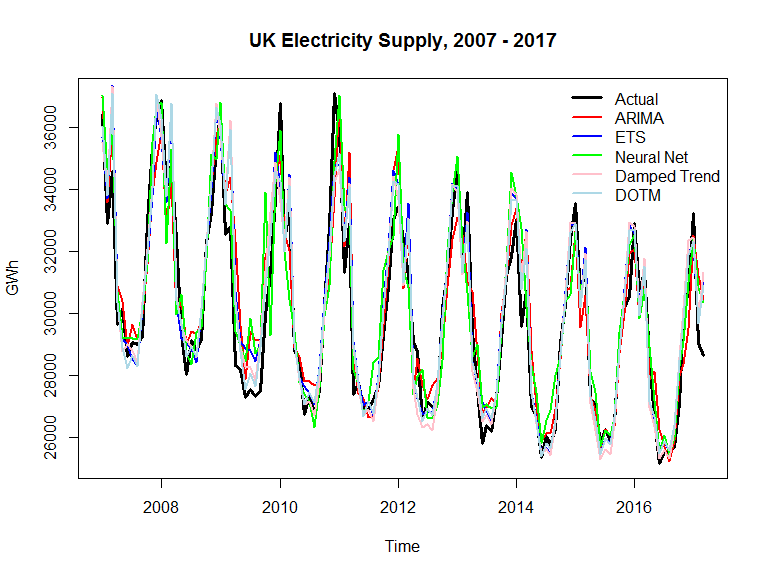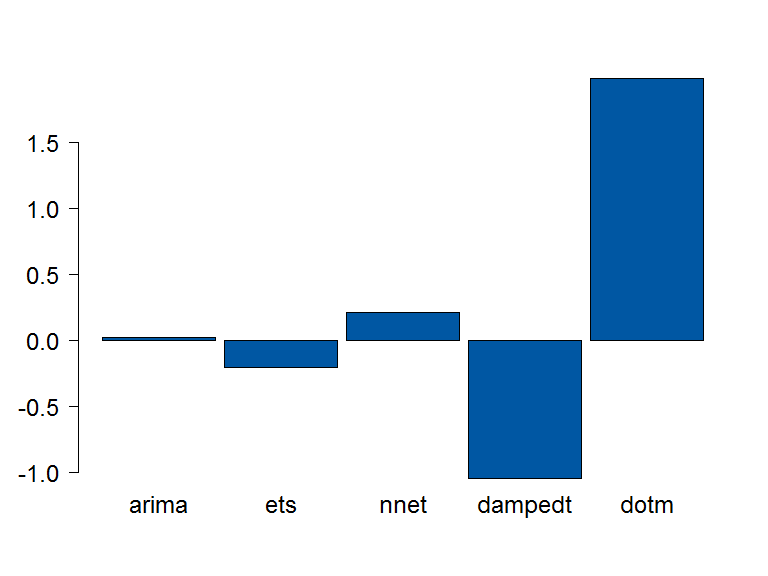R in Finance
Eran Raviv
June 2, 2018
Three parts to this talk
-
On the
ForecastCombpackage - Other things combinations
-
How the
ForecastCombcame to be
Part 1
The ForecastComb package
Start with an example

Data preparation
train.obs <- electricity[1:84, 6]
train.pred <- electricity[1:84, 1:5]
test.obs <- electricity[85:123, 6]
test.pred <- electricity[85:123, 1:5]
input_data <- foreccomb(train.obs, train.pred,
test.obs, test.pred)Individual performance
indi_perf <- matrix(nrow = 5, ncol = 2)
colnames(indi_perf) <- c("Train", "Test")
rownames(indi_perf) <- input_data$modelnames
for (i in 1:5){
indi_perf[i, 1] <- RMSE(train.pred[,i], train.obs)
indi_perf[i, 2] <- RMSE(test.pred[,i], test.obs)
}| Train | Test | |
|---|---|---|
| arima | 1.24 | 0.99 |
| ets | 1.17 | 0.87 |
| nnet | 1.27 | 0.98 |
| dampedt | 1.18 | 0.92 |
| dotm | 1.04 | 0.77 |
“…combining multiple forecasts leads to increased forecast accuracy. In many cases one can make dramatic performance improvements by simply averaging the forecasts.” (source: Forecasting: Principles and Practice. Rob J Hyndman and George Athanasopoulos)
OLS combination
\[ y_t = {\alpha} + \sum_{i = 1}^P {\beta_i} f_{i,t} +\varepsilon_t.\]
The combined forecast is then given by:
\[f^{comb} = \widehat{\alpha} + \sum_{i = 1}^P \widehat{\beta}_i f_i.\]
Simple combination
Does not outperform the best model:
| Train | Test | |
|---|---|---|
| arima | 1.24 | 0.99 |
| ets | 1.17 | 0.87 |
| nnet | 1.27 | 0.98 |
| dampedt | 1.18 | 0.92 |
| dotm | 1.04 | 0.77 |
# Simple Average
SA <- comb_SA(input_data)
as.data.frame(names(SA))> names(SA)
> 1 Method
> 2 Models
> 3 Weights
> 4 Fitted
> 5 Accuracy_Train
> 6 Forecasts_Test
> 7 Accuracy_Test
> 8 Input_DataformatC(SA$Accuracy_Test[,"RMSE"]/1000)> [1] "0.7823"OLS combination
Indeed outperform the best model:
| Train | Test | |
|---|---|---|
| arima | 1.24 | 0.99 |
| ets | 1.17 | 0.87 |
| nnet | 1.27 | 0.98 |
| dampedt | 1.18 | 0.92 |
| dotm | 1.04 | 0.77 |
# OLS combination
OLSA <- comb_OLS(input_data)
formatC(OLSA$Accuracy_Test[,"RMSE"]/1000)> [1] "0.6715"OLS Weights
A linear combination of couple of models
How come it works?
What can the ForecastComb package do for you?
- Trivial
- Simple. Median. Trimming.
- Accuracy-based
- (Inverse) Rank. (Inverse) RMSE. Eigenvector approach.
(Cheng Hsiao and Shui Ki Wan. Is there an optimal forecast combination? JOE, 178:294-309, 2014)
What can the ForecastComb package do for you? (cont’d)
- Regression based methods
- OLS, LAD, CLS
- Complete subset regressions
- Structure
- Plotting, summary and predict methods
Part 2
Other things combination
Many widely used statistical techniques implicitly use forecast combination
- Bagging
- Random Forest
- Moving average
- Shrinkage
- Inception blocks in ConNN
\[ D_t = (1-\lambda) \sum_{t=1}^ \infty \lambda^{t-1} (\varepsilon_{t-1}\varepsilon^ \prime_{t-1}) = (1-\lambda)(\varepsilon_{t}\varepsilon^ \prime_{t})+\lambda D_{t-1} \]
\[ \Sigma_{Combined}= \alpha \Sigma_{1} + (1-\alpha) \Sigma_{2} \]
For time series
- Across different windows
- Across forecasting horizon
-
Rectify
Recursive and direct multi-step forecasting: the best of both worlds
- For hierarchical time series
-
Across information criteria
The weighted average information criterion for multivariate regression model selection
For densities/probability
- For densities from VAR
- More generally
- For probability forecasts
- For VaR
Even more
- In factor models
- Considering outliers
- Across quantiles
- Now on my to read list:
Simplicity makes me happy (Alicia Keys)
- “empirical studies have shown that such a simple equally weighted pooling of forecasts performs quite well in practice, relative to other approaches that rely on estimated combination weights, a phenomenon dubbed the forecast combination puzzle.”
-
“One of the puzzles for forecast combination is the documentation of simple average (or equally weighted combination) dominating more sophisticated forecast combinations (e.g. Huang and Lee (2010), Palm and Zellner (1992) and Stock and Watson (2004)).”
(Cheng Hsiao and Shui Ki Wan. Is there an optimal forecast combination? JOE, 178:294-309, 2014)
- Intuitive explanation here:
Part 3
A package is born
With an email
…
Partners in crime
Chris E Weiss

Gernot Roetzer
Yours truly

Yet we have yet to meet
Collaboration and hard work
Work in progress